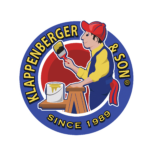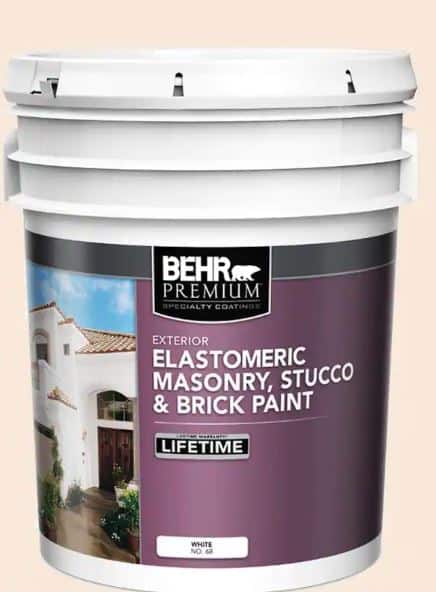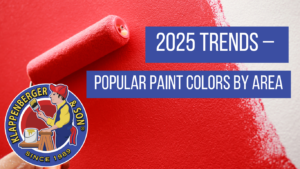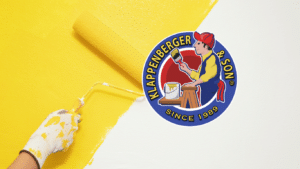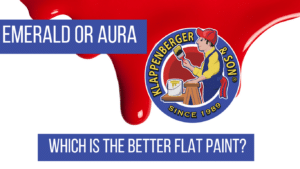
Choosing the best stucco paint for 2024 will depend on what previous product(s) were applied and how many coats.
If you don’t know the number of coats and what products were applied don’t worry, I’ll offer some suggestions.
First, why does it matter what products and number of coats? To be able to recommend the best stucco paint for 2024, it’s good to know that rain will eventually get behind the paint when there is sustained driving rain.
When this happens, one of two things will occur. Either the moisture will pass through the layers, or it will get trapped.
If moisture passes moisture through, all is well. If it gets trapped, it will either begin to deteriorate the stucco or create bubbles. Sometimes, very large bubbles can hold a couple of gallons of water!
Elastomeric Vs. Acrylic Masonry Paints
There are many different options for finding the best paint for stucco. I could probably find 100 paints suitable for stucco if I searched long enough. For example, Sherwin Williams has 15 different products made explicitly for masonry surfaces.
To shorten the list, I will divide the choices into three camps, namely acrylic masonry, elastomeric paint systems, and universal exterior paints.
Regardless of what paint you choose, the job should start with a good power washing to remove chalkiness, mildew, and dirt.
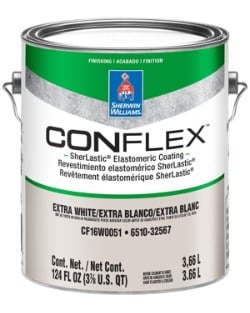
Elastomeric paints are very flexible.
How flexible? How about 300 – 600%!
Elastomeric is like rubber in a paint can.
It is a waterproof paint system. When you hear “paint system,” you might have to use specific primers and conditioners before applying the elastomeric top coats.
Elastomeric paint also very thick. It’s about 2-3 times the thickness of your typical exterior paint.
On the surface, no pun intended; these qualities make it an excellent paint for stucco, or does it?
But Is Elastomeric The Best Paint For Stucco?
The Advantages Of Elastomeric On Stucco
When Elastomeric paint is applied correctly, it is a waterproof paint. It’s also a very thick paint, allowing it to bridge gaps and minor cracks.
Ben Moore UltraSpec Elastomeric has a 300% elongation.
In addition to its flexibility, the thickness gives it an exceptionally high build. One coat of Elastomeric has 2-3 times the thickness of a coat of standard acrylic paint. Over time, this can cause problems.
The Disadvantages Of Elastomeric On Stucco
Pin holes are the small areas that the elastomeric paint did not cover. These small pin holes happen when rolling too quickly, causing bubbling. The result is that these pin-size holes allow water to enter behind the waterproof paint. Moisture then cannot transfer through the paint and collects behind the paint like water in a balloon.
The solution would be to apply a block filler on the stucco to ensure all pin holes are gone. Then, use either another coat of Elastomeric or any acrylic exterior paint.
A few elastomeric paints are breathable and allow moisture to transfer; UltraSpec is one. However, most elastomeric paint systems are not breathable.
Therefore, elastomeric would not be a good choice if you believe there are any areas outside the house where water can get behind the paint.
Because the paint is thick, a gallon of elastomeric only spreads between 80-100 square feet per gallon. That’s about a third of what universal exterior paints would cover.
Though most elastomeric paints dry to the touch in 2 hours, a re-coat must wait until the following day. Having to wait this long between coats could increase the labor cost.
Elastomeric paints, such as Conflex Sherlastic, need to be applied when temperatures are above 50 degrees for 24 hours. Other masonry paint, such as Loxon XP, can be used when surface temperatures exceed 35 degrees.
Finally, if the surface still has chalkiness after power washing, it will need to be primed with a masonry conditioner. Other acrylic masonry paints can go directly over chalky surfaces.
When to use Elastomeric Paint
Elastomeric paints are a good choice if you have a substrate with little or no paint, AND water may be getting in. That’s about the only time I can see using a non-breathable water-proofing paint.
What Makes Elastomeric Great Can Also Be Its Downfall
Most exterior surfaces get moisture behind the paint from time to time. Moisture may even come from the inside of the property and pass through the walls and the exterior substrate. The passing of moisture from the substrate through the exterior paint is called “breathing.” Now that you understand that walls need to breathe, you can probably see how applying a rubbery paint that is 2-3x thicker than regular paint can quickly prevent the walls from breathing. Applying three coats of elastomeric paint is like applying nine coats of standard paint. When this much paint is applied, it doesn’t allow the substrate to breathe. The result is bubbling or worse. The brick and cement begin to crumble.
Anthony - Ben Moore Regional Manager Tweet
Data Elastomeric Paints Made For Stucco
Elastomeric Paints
Product | temp | coverage | Wet mil/dry mil | Recoat time | Sheens available | Bridges cracks | water proof | Self-priming # of cts needed | Notes |
Sherwin Williams | 50 degrees | 107-145 | 22/10 | 24 | Flat | Yes | Yes | No 1-2 |
|
Ben Moore UltraSpec Masonary Elastomeric | 50 degrees | 60-80 | 20/9 | 12 hrs. | Flat/Low Luster | Minor cracks up to 1/32” | Yes | No 2 | Breathable |
PPG Perma-Crete Pitt Flex Elastomeric | 50 degrees | 100-135 | 14/6 | 4 hrs. | Flat | Yes | Repels water | No 2 | Breathable |
Acrylic Masonry Paints
Benefits of Acrylic Masonry Waterproofing Paint
Let me mention that elastomeric paint is acrylic paint. However, it has some slight differences from acrylic masonry paints worth mentioning.
The first advantage is that acrylic masonry (A.M.) paints can be applied when temperatures are as low as 35 degrees.
Secondly, A.M. paint is not a paint system. This means it can go directly over new concrete without priming.
Cons Of Acrylic Masonry Paint Vs. Elastomeric
The experts I spoke to believe elastomeric has a slight edge in waterproofing, and the data supports that claim. However, masonry paints are breathable which allows air and moisture to not get trapped behind the paint.
Below is a short list, in no particular order, of excellent acrylic masonry paints.
Romabio is in a class by itself
Romabio is a mineral-based paint with potassium silicate. It calcifies with the brick and won’t peel! The best part is that Romabio offers a 20-year warranty when properly applied. The texture is flat, but it has two finishes: masonry flat and slurry.
The lime used to make Romabio paints is not your garden variety. It comes from the Dolomite Mountains in Italy and has been used for 2000 years.
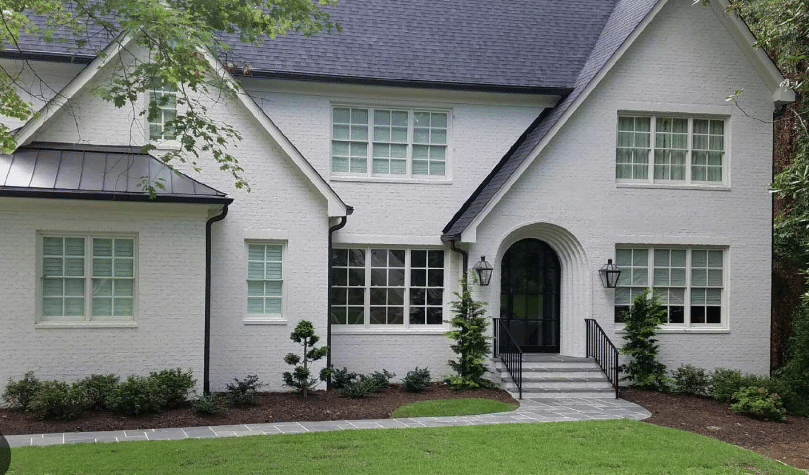
Product | Temp. | Sq. ft. cov. | wet/dry | Recoat time | Available Sheens | Breathable | Self-Priming # of cts | Notes |
Behr Masonry Stucco Brick Paint | 35 – 90 degrees | 185-110 | 216/8 | 4 hrs. | Flat | Yes | Yes / 2 | Excellent color retention |
Romabio Masonry paint | 50-90 | 240-400 |
| 4 hrs. | Flat | Yes | No priming on unpainted surfaces. | Excellent color retention |
PPG Perma Crete | 50 -90degrees | 100-135 | 14/6 | 4 hrs. | Flat | Yes | No / 1 | Good color retention |
Sherwin Williams Luxon | 35-90 | 85-100 | 16/8 | 4 hrs. | Flat | No | Yes / 2 | Poor color retention |
|
|
|
|
|
|
|
|
|
What About Using Universal House Paints For Stucco?
By “universal” paints, I mean paints that can be used on many surfaces, such as wood, vinyl, metal, stucco, etc. In other words, they are your standard or universal house paints.
Comparing them to acrylic masonry paints and elastomeric, it is easy to see the pros and cons.
The Pros of using Universal Exterior Paints
First, universal paints’ coverage is 2 -3 times greater. Secondly, you can choose any sheen. Thirdly, most dry faster than the acrylic masonry paints and elastomeric, making it easier to apply two coats in one day.
The Cons of using Universal Exterior Paints
The most glaring weakness of universal paints is the thickness. Elastomeric and acrylic masonry paints are 2-3 times thicker, which explains their poor coverage.
Experts agreed that even when one coat looks good, two coats add durability, protection, and longevity. If you can afford to apply a second coat, it will pay big dividends down the road.
Below is a short list in no particular order of excellent universal exterior paints.
Product | Temp | Coverage | Wet mil/dry mil | Recoat time | Sheens available | Bridges cracks | water proof | Self-priming | # of coats needed |
40 | 250-350 | 5/2.3 | 4 hrs. | All | Nope | Nope | It is not | 1-2 | |
50 | 250-300 | 5/2.3 | 4 hrs. | Most | No | No | Yes | 1-2 | |
35 degrees | 250-300 | 6/2.5 | 24 hrs. | All | No | Sorry no | Yes it is | 1 |
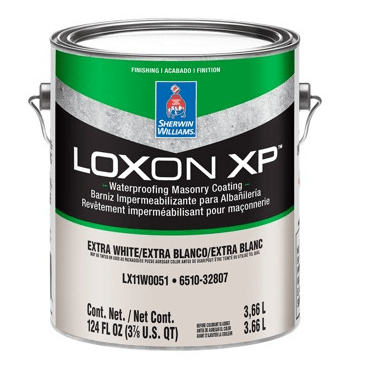
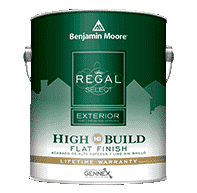
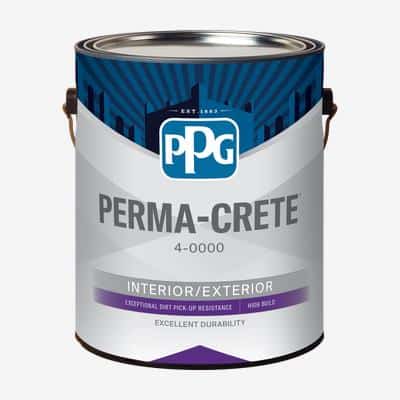
Conclusion: What Is The Best Paint For Stucco?
I wasn’t expecting any of the regional sales reps to suggest a paint outside of their brand, but I was surprised they all chose the acrylic masonry paint.
Sherwin Williams Regional Sales Rep – picks Luxon XP
Ben Moore Regional Sales Rep – picks Regal High Build
PPG Regional Sales Rep – picks Perma-Crete
Surprisingly, none of the experts picked Elastomeric Paint Systems. Why?
Sherwin Williams Regional Sales Rep – “Luxon XP is easy to use, more available, and self-priming. In short, fewer variables than Conflex.”
Ben Moore Regional Sales Rep – picks Regal High Build.
“There are 350 square feet of coverage per gallon; some sheens are very mildew resistant, with excellent color retention.”
PPG Regional Sales Rep – picks Perma-Crete.
“It is a breathable, waterproof system that won’t trap moisture that must transfer through the paint.”
